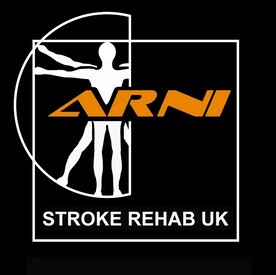This post, about V-Health, is a follow up to our ARNI Stroke Rehab UK post of a few days ago about XR tech✨ This cutting-edge platform, particularly the v-health XR system combines VR with patented FES wearable bands 🦾🎮 called 'eir bands' (!) that wrap around the arm to provide real-time muscle stimulation while you perform tasks in a digital world like reaching for objects or playing specialised games designed to rewire the brain through neuroplasticity 🧠⚡️.
Stroke survivors are finding it far more engaging than standard exercises because it turns repetitive movements into a motivating, gamified experience that you can even do from the comfort of your own living room. Currently, this tech is available at specialist private clinics like VIM Health in West Sussex, which offers intensive rehabilitation packages using state-of-the-art robotics and VR 🏥📍.
It's also being piloted and tested in collaboration with NHS trusts such as Hillingdon Hospitals and academic partners like Brunel University to make it a standard part of UK stroke care pathways 🤝🎓. For those looking for remote options, platforms like v-health Mobile allow clinicians to monitor your progress and adjust stimulation levels wirelessly via a tablet or phone, ensuring you stay on track with the crucial golden window of recovery without constantly traveling to a hospital 📱📉🦾✨
w#ARNIstrokerehabA#VHealthe#neurorehabl#HealthTechUKb#digitalhealth #DigitalHealth
... See MoreSee Less
A core part of the ARNI approach is to teach stroke survivors how to cope with falls; the most dangerous part of the balance problems caused by stroke.
Survivors (many of whom have the functional use of just one arm) learn how to get down to, and up from, the floor without any kind of external support to pull themselves up with.
www.arni.uk.com
#strokerecovery #ARNIstrokerehab #neuroplasticity #ARNIstrokerehab #arnistroke #neurorehab #arnistrokecharity #strokesurvivorscan
... See MoreSee Less
Constraint-Induced Movement Therapy (CIMT) is a stroke rehabilitation technique that involves restricting your unaffected side while forcing the use of your affected side. It can be quite frustrating if the affected side has severely limited mobility and then the you’re asked to complete exercises with that side for multiple hours per day (as typical CIMT protocol requires).
Although it can be frustrating and aggressive, CIMT has an established track record of helping improve movement after stroke.
www.arni.uk.com
#strokerehabilitation #neurorehab #strokerehab #neuroplasticity #arnistroke #neurorehabilitation #strokesurvivorscan #strokeexercise
... See MoreSee Less
Did you know that 'Extended Reality' (XR) is cost-effective and evidence-based complement to stroke recovery 🚀? So what is it?? This innovative tech is basically a combo of Virtual Reality (VR): Fully immersive worlds for tasks, Augmented Reality (AR): Overlays digital info onto the real world (e.g., apps for spatial tasks), Mixed Reality (MR): Blends real and virtual, offering interactive experiences and Haptic Feedback: Devices provide physical sensations to guide movements. And other tech like FES can be bolted on in the mix...
XR is currently being used in hospitals like the Royal Berkshire Hospital and through Belfast Health and Social Care Trust to help survivors regain movement and confidence through immersive, game-like environments 🎮. Unlike traditional physio, which can sometimes feel repetitive or exhausting, XR makes rehabilitation fun by simulating real-world tasks like grocery shopping or navigating public transport in a safe, virtual space 🏥.
While standard tech like robotic gloves (around £60–£100) or high-end treadmills (£4,000+) focus on isolated physical support, XR provides instant visual feedback and data-driven insights that can be 2–3 times cheaper than traditional intensive rehab when delivered remotely 💸.
In fact, major 2025 NHS-funded initiatives from companies like Reneural and eXRt Intelligent Healthcare are now making it possible to access these therapies directly from home 🏠. For those looking to try this tech=, it's increasingly available through specialist NHS units such from the Hillingdon Hospital or private centers like the St John & St Elizabeth Hospital Stroke Rehab Clinic in London 📍.
Whether you are working with an ARNI Stroke Rehab Instructor or using a headset in your living room by yourself, XR is proving to be a powerful supplement to conventional care, helping the brain rewire through plasticity and engaging practice ✨.
www.arni.uk.com
#ARNIStrokeRehabUK #ExtendedReality #HealthTechUK #NeuroRehab #NHSInnovation
... See MoreSee Less
Ever wondered how our ancestors dealt with the 'struck down' mystery of a stroke back in the Middle Ages? 🏰📜 In those days, a stroke or brain haemorrhage was known as Apoplexy, and because it happened so suddenly, people often believed the person had been struck by a divine or supernatural blow...⚡🧠
Medieval doctors followed the theory of the four humours and believed apoplexy was caused by an excess of cold, moist 'phlegm' blocking the flow of spirit to the brain. To fix this, they turned to intense treatments like bloodletting from specific veins or using cupping to draw out the bad humours. 🩸😱 They also used pungent smells like vinegar or burnt feathers to try and 'wake' the patient from their stupor. 👃🔥
But when it came to rehabilitation, they actually understood more than one might think - while they didn't have modern neurophysio, fascinating, famous medical texts like those by Avicenna suggested that survivors should be treated with warm oil massages, gentle exercise and specific diets to regain their strength. 🧴🥖 They recognised that the body needed to be 're-warmed' to regain movement in paralysed limbs.
We even have incredible physical evidence that people survived and were cared for long-term... archaeological studies of medieval skeletons often show disuse atrophy in arm or leg bones, proving that individuals lived for years with hemiplegia. One really famous example is a 2,700-year-old Egyptian mummy buried with a custom-made wooden crutch, showing that their communities didn't just give up on them; they provided the tools to keep them mobile. These are also found in medieval graves/tombs 🩼❤
Contemporary accounts from 'miracle' books at shrines also describe people who had lost their speech or the use of their limbs being brought to holy sites for healing. While they called it a miracle, these records give us a fascinating look at stroke survivors navigating a world without modern medicine. It just goes to show that the human spirit and the drive to recover have been prett#ARNIstrokerehabf#medievalhistoryy#medicalhistoryr#archaeologyRNIStrokeRehab #MedievalHistory #MedicalHistory #Archaeology
... See MoreSee Less
⚠️ PLEASE READ: A Vital Health Warning for the Days After Christmas ⚠️So, while the big day is over (with apparently some 240 people having a stroke on Christmas day in the UK), the danger isn't - did you know that right now, the period between Boxing Day and New Year, is one of the highest-risk times for strokes in the UK... 🧠❄️
Why is this danger spike happening right now? Well, days of leftover turkey, salty snacks, and celebratory drinks put massive strain on your blood pressure. 🧀🍷 And obviously, alcohol-induced heart rhythm issues (like AFib) are a major trigger for strokes. And also, the current winter snap causes blood vessels to constrict, increasing the risk of clots. 🌡️🧊
And an obvious NHS Reality Check 🏥🚨: it's a scary time to be ill. As we head into 2026, our NHS is under immense pressure: response times are still struggling, and every minute saved is brain function saved. 🚑 A&E departments are facing record-high winter pressures, meaning long waits and bed shortages even after you arrive. With many staff on leave or off sick, ARNI Stroke Rehab UK knows that specialist stroke wards are right now stretched to the limit.
But don't 'Wait and See' 🚫🤫 We do hear about people waiting until after the holidays to 'bother' a doctor because they don’t want to disrupt the family or deal with a busy hospital. Please share this post to people to remind them NOT to do this... people need to know that if they wait, it might be too late for life-saving clot-busting treatments.
Stay safe and and look out for your elderly relatives this week ❤ Let's make it to 2026 healthy! ✨
For more advice on stroke prevention and stroke rehabilitation, visit ARNI Stroke Rehab UK Charity.
www.arni.uk.com
#ARNIStrokeRehab #NHS #ActFAST #UKHealth
... See MoreSee Less
THE ARNI ARMY XMAS MOUSE SAYS HAPPY XMAS TO ALL STROKE SURVIVORS AND THEIR FAMILIES, AND TO ALL ARNI PT INSTRUCTORS! ;)
... See MoreSee Less
Happy Xmas from ARNI Stroke Rehab UK! This pic was created by young stroke survivor @Alex Roantree-Roesch, a young stroke survivor who first came to ARNI Stroke Rehab Charity as a very young lad - and still comes along to training to this day - Happy Xmas to Alex, his mum and dad - and @Sally Roesch (who is also on ARNI Stroke Rehab & Recovery Facebook too) 😉Alex made this as a Xmas card using his more-affected hand, practising placing his fingers flat enough on the paper to make Santa's beard! Well done Alex! This image served as the ARNI Xmas card for at least 5 consecutive years because we liked it so much!
... See MoreSee Less
✨ Staying Connected and Strong Together This Christmas! ✨ Christmas time season can be a bit of a whirlwind, and for many in our stroke survivor community, it sometimes brings feelings of isolation or the heavy pressure to keep up with the festivities.
When your energy levels have changed, communication feels like an uphill battle, or your confidence isn't quite where it used to be, the bright lights and loud rooms can feel a little overwhelming. 🎄💔 ARNI Stroke Rehab UK charity reminds you you are not alone in feeling this way and that your journey is valid exactly as it is. One of the most powerful things we can do as survivors is to reach out and lift each other up during these weeks. 🤝💪
Whether it is sending a simple text to a fellow survivor just to say 'I'm thinking of you' or sharing a quiet moment of understanding that doesn't require any words at all, these small acts of connection can break through the feeling of being left out. Let’s remind one another that it is perfectly okay to step away for a rest when neuro-fatigue hits or to take all the time you need to find your words. 🧠💤 🛡️✨
To help keep that sense of community alive, ARNI Stroke Rehab UK is staying right by your side throughout the entire holiday period! 📱🌟 We will be continuing to write and share Facebook posts about stroke issues every single day over Christmas and all the way into the New Year. We want to ensure that whenever you log on, you find a helpful tip, a bit of encouragement, or a reminder that there is a whole family of survivors rooting for you. 🗓️🚀
If you are looking for a way to truly tackle those feelings of isolation and build your confidence back up for 2026, a fantastic way to do that is to get matched with a low-cost ARNI stroke rehab instructor. 🏋️♂️🏠
You can start planning your next steps by visiting the ARNI Stroke Rehab UK website today.... and please ask questions of us - Dr Tom and his staff are available for you via email throughout Xmas if you need them L🧠💪
www.arni.uk.com
#ARNIStrokeRehab #StrokeRecovery #ChristmasSupport #Neuroplasticity #StrokeAwareness #CommunityStrength #NeverGiveUp
... See MoreSee Less




One Comment
Interested in intensive gait training